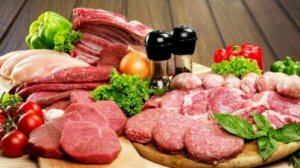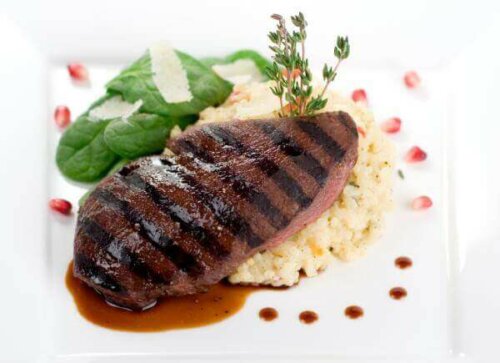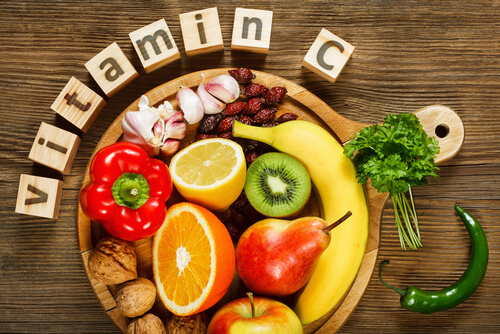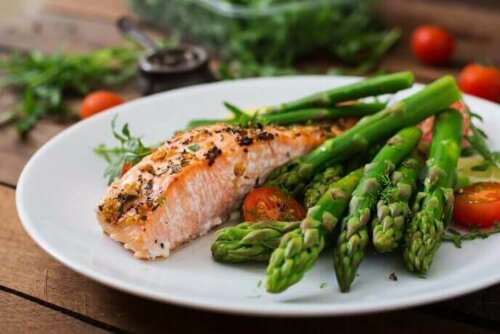7 Foods that Help Maintain Normal Hemoglobin Levels

Anemia is one of the most common diseases and we define it as a pathological reduction of normal hemoglobin levels. Today’s article will describe how it occurs.
One day, you climb a ladder and realize that you feel extremely tired. Then, you realize that sometimes your heart beats too hard, for no apparent reason. You get scared and go to the doctor.
Fortunately, it’s not as serious as you thought. “You have low hemoglobin levels,” the doctor says, “you’re just anemic.” You breathe a sigh of relief, you come out of the doctor’s office and suddenly you have a question, “What should I eat to maintain normal hemoglobin levels?”
This situation is common, believe it or not. Often, we’re so intent on understanding what medication the doctor prescribes that we forget to ask what we can do at home to improve the condition. The best way to do so is through food, in fact, so we’re going to share some advice in today’s article.
Foods that help maintain normal hemoglobin levels
According to information from the Mayo Clinic, hemoglobin is a blood protein that carries oxygen throughout the body. This is a recurring finding in blood tests.
Low hemoglobin counts are defined as below 13.5 grams per deciliter in men or 12 in women. In children, the definition varies with age and sex.
When these levels are slightly below those considered normal, there may be no symptoms. However, lower values may affect normal life and indicate anemia.
The causes of low hemoglobin levels can vary and have different origins:
- As a result of some disease that affects the amount of existing red blood cells (aplastic anemia, cirrhosis, chronic nephropathy or cancer among others)
- Due to significant blood loss: bleeding in the digestive tract, heavy menstruation, regular blood donations
- Problems absorbing iron
- Lack of some key nutrients such as B vitamins (B9 and B12) and iron
Note that low hemoglobin values are sometimes normal and don’t usually indicate a health problem. This can happen during pregnancy and menstruation.
The treatment focuses first of all on discovering the cause in order to solve it. Note that it isn’t always possible to raise hemoglobin levels on your own.
However, a proper diet can help maintain red blood cells and hemoglobin in good condition. This should be wholesome and well-balanced, and include important nutrients.
Foods to maintain normal hemoglobin levels
The following are great for this purpose.
1. Red meat and liver

Foods with a high contribution of iron should be a part of this type of diets. There are many valid sources, but the most outstanding (and known by the general public) are red meat and viscera such as liver.
However, their regular consumption isn’t recommended and you must be moderate and not exceed your weekly ration.
In addition, liver can lead to adverse reactions and it isn’t to everyone’s liking. But, there are some tasty ways to make it and learn to like it.
Check out these Three Easy and Delicious Fish Recipes
2. Other foods that provide iron: legumes and nuts
When it comes to foods of vegetable origin, iron is also present, although they are not usually considered as first choices because it is more difficult for the body to assimilate it.
Particularly worth mentioning are legumes, as they’re a wholesome food from a nutritional point of view.
As highlighted in a study published in Nutrition Reviews, this is one of the foods that provide ferritin, a protein that encapsulates large amounts of iron, a key nutrient for optimal hemoglobin levels.
Among the legumes we find:
- Soybeans
- Beans
- Lentils
- Chickpeas
Likewise, in some nuts and seeds we also find appreciable values of iron. These are pistachios, pine nuts, cashews, pumpkin seeds and chia.
Although these are not ingested in such significant quantities, they’re easy to add to the diet and represent a small extra amount of this mineral.
3. Foods that provide vitamin C
This vitamin does not by itself increase the amount of red blood cells in the blood. But it is a very beneficial element for the proper absorption of iron, as observed in a study published in 2016 in the journal Aging.

Given what we’ve said above, below we present a list of vegetables with the most vitamin C. Fortify all of your dishes to attain normal hemoglobin levels by using any of these.
- Peppers, especially raw
- Broccoli, Brussel sprouts
- Parsley
- Spinach, beets, carrots
- Citruses like pomelo, orange, and lemon
- Other fruits like kiwi, strawberries, and pineapple
Check out 8 Symptoms of a Vitamin C Deficiency
4. Foods rich in folic acid
Folate isn’t only important during pregnancy but also for maintaining normal hemoglobin levels. This is because folic acid promotes the proper development of red blood cells.
However, we’re used to only referring to it in the context of typical tablets taken during pregnancy. Therefore, we often don’t know what other sources contain it.
- Soy
- Beans
- Oranges
- Avocado
- Asparagus
- Wheat germ
- Pumpkin seeds
- To these, we must add other foods mentioned in the other sections, such as green vegetables, legumes, and liver
5. Oily fish

Oily fish has all the advantages of the previous foods but stands out for its vitamin B content, essential for the production of red blood cells.
Increase your intake of:
- Tuna
- Mackerel
- Salmon
- Sardines
6. Foods with vitamin A and beta-carotene can also increase hemoglobin levels
According to research published in The Journal of Nutrition, both vitamin A and beta-carotene can help improve iron absorption. Therefore, their consumption can help increase hemoglobin levels.
Foods rich in vitamin A include:
- Liver
- Fish
- Sweet potatoes
- Kale and cabbage
Foods rich in beta-carotene include yellow, red, and orange fruits and vegetables, such as:
- Mangoes
- Melons
- Carrots
- Sweet potatoes
7. Chicken and turkey
White meat doesn’t contain as much iron as red meat. But, it provides significant amounts of vitamin B12. A deficit of which can impair the synthesis of red blood cells.
Also known as cobalamin, this nutrient is present in foods of animal origin. Other good sources are seafood, eggs and dairy products.
The best way to eat for normal hemoglobin levels
The treatment of each situation will depend on the case and its particular causes. However, importance is often given to the nutritional part. In fact, a publication in The American Journal of Clinical Nutrition points out that nutritional education is a determining factor.
Beyond food, there are other aspects of food intake and presentation that should be taken into account to improve its effectiveness.
- Don’t mix iron-containing foods with tea and coffee.
- Some cases may require the use of iron supplements but only if your doctor recommends it and on an empty stomach and with vitamin C sources. Also, don’t eat calcium supplements at the same time as iron supplements.
- Diets should be nutritious and contain an adequate caloric intake according to the age, sex, condition, etc., of each person. This is also a good way to restore tiredness and fatigue, no doubt.
- To preserve the vitamins and nutrients of the food, it’s best to subject them to short cooking times.
Try these foods to obtain normal hemoglobin levels
As long as it isn’t a symptom of a more aggressive disease, a lack of hemoglobin is easy to control. It may be enough to introduce this series of foods more frequently and you’ll soon start to feel better.
However, be sure to consult a health professional in the presence of certain symptoms (fatigue, weakness, pale skin and gums, shortness of breath or irregular rapid heartbeat).
It’s also necessary to know that these measures can lead to improvement but will never replace medical treatment.
All cited sources were thoroughly reviewed by our team to ensure their quality, reliability, currency, and validity. The bibliography of this article was considered reliable and of academic or scientific accuracy.
- Brear EM, Day DA, Smith PM. Iron: an essential micronutrient for the legume-rhizobium symbiosis. Front Plant Sci. 2013;4:359. Published 2013 Sep 13. doi:10.3389/fpls.2013.00359.
- Cleveland Clinic. Low hemoglobin. Abril 2022.
- Clinica Mayo. Low hemoglobin count. Mayo 2022.
- Coates TD. Physiology and pathophysiology of iron in hemoglobin-associated diseases. Free Radic Biol Med. 2014;72:23–40. doi:10.1016/j.freeradbiomed.2014.03.039
- Finkelstein FO, Juergensen P, Wang S, et al. Hemoglobin and plasma vitamin C levels in patients on peritoneal dialysis. Perit Dial Int. 2011;31(1):74–79. doi:10.3747/pdi.2009.00154.
- García-Casal M. N, Layrisse N, et al. Vitamin A and betacarotene can improve nonheme iron absorption from rice, wheat, and corn by humans. Journal of Nutrition. Marzo 1998. 128 (3): 646-50.
- Kankanamge, Upekshi & S, Ariyarathna & Perera, P P R. (2017). Association between dietary patterns and Hb concentration among young adult females. International Journal of Current Research. 9. 45497-45500.
- Kim YL. Vitamin C and functional iron deficiency anemia in hemodialysis. Kidney Res Clin Pract. 2012;31(1):1–3. doi:10.1016/j.krcp.2011.12.008
- Kumar, T., Taneja, S., Sachdev, H. P. S., Refsum, H., Yajnik, C. S., Bhandari, N., & Strand, T. A. (2017). Supplementation of vitamin B12 or folic acid on hemoglobin concentration in children 6–36 months of age: A randomized placebo controlled trial. Clinical Nutrition. https://doi.org/10.1016/j.clnu.2016.07.002
- Lane D. J, Jansson P. J, et al. Bonnie and Clyde: vitamina C ans iron are partners in crime in iron deficiency anemia and its potential roles in the elderly. Aging. Mayo 2016. 8 (5): 1150-1152.
- Li RR, Yu QL, Han L, Cao H. Nutritional Characteristics and Active Components in Liver from Wagyu×Qinchuan Cattle. Korean J Food Sci Anim Resour. 2014;34(2):214–220. doi:10.5851/kosfa.2014.34.2.214
- Martínez, C., Ros, G., Periago, M. J., & López, G. (1999). Biodisponibilidad del hierro de los alimentos. Arch Latinoam Nutr, 49(2), 106-13. https://www.researchgate.net/profile/Gaspar-Ros/publication/270959331_Biodisponibilidad_del_hierro_de_los_alimentos/links/54ba9ffa0cf29e0cb04bd42f/Biodisponibilidad-del-hierro-de-los-alimentos.pdf
- Medline Plus. Vitaminas B. Biblioteca Nacional de Medicina de Estados Unidos.
- Mirone L. Hemoglobine leves and dietary intake of adults. The American Journal of Clinical Nutrition. Enero 1954. 2 (1): 38-42.
- Prentice AM, Mendoza YA, Pereira D, et al. Dietary strategies for improving iron status: balancing safety and efficacy. Nutr Rev. 2017;75(1):49–60. doi:10.1093/nutrit/nuw055
- Sidhu, K. S. (2003). Health benefits and potential risks related to consumption of fish or fish oil. Regulatory Toxicology and Pharmacology. https://doi.org/10.1016/j.yrtph.2003.07.002
- Toxqui, L., Piero, A. D., Courtois, V., Bastida, S., Sánchez-Muniz, F. J., & Vaquero, M. (2010). Deficiencia y sobrecarga de hierro: implicaciones en el estado oxidativo y la salud cardiovascular. Nutrición Hospitalaria, 25(3), 350-365. https://scielo.isciii.es/pdf/nh/v25n3/revision3.pdf
This text is provided for informational purposes only and does not replace consultation with a professional. If in doubt, consult your specialist.








